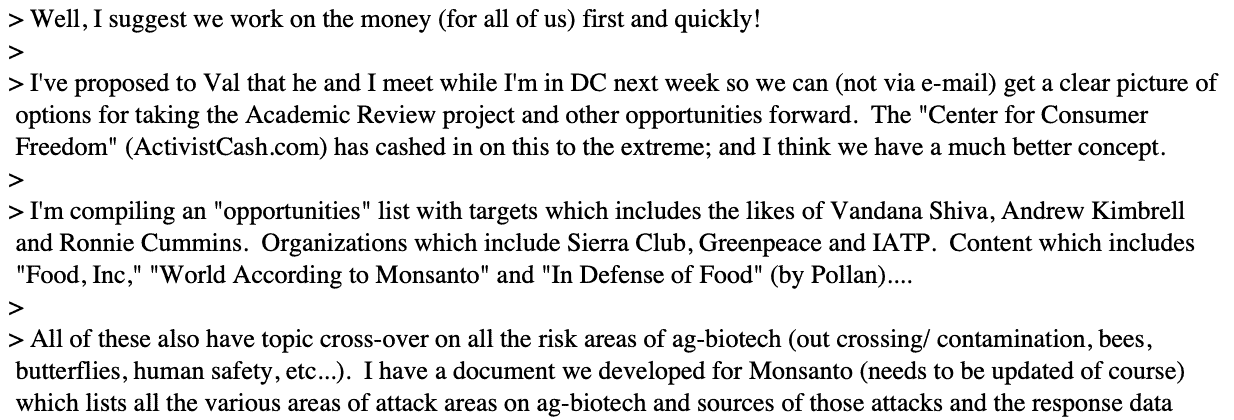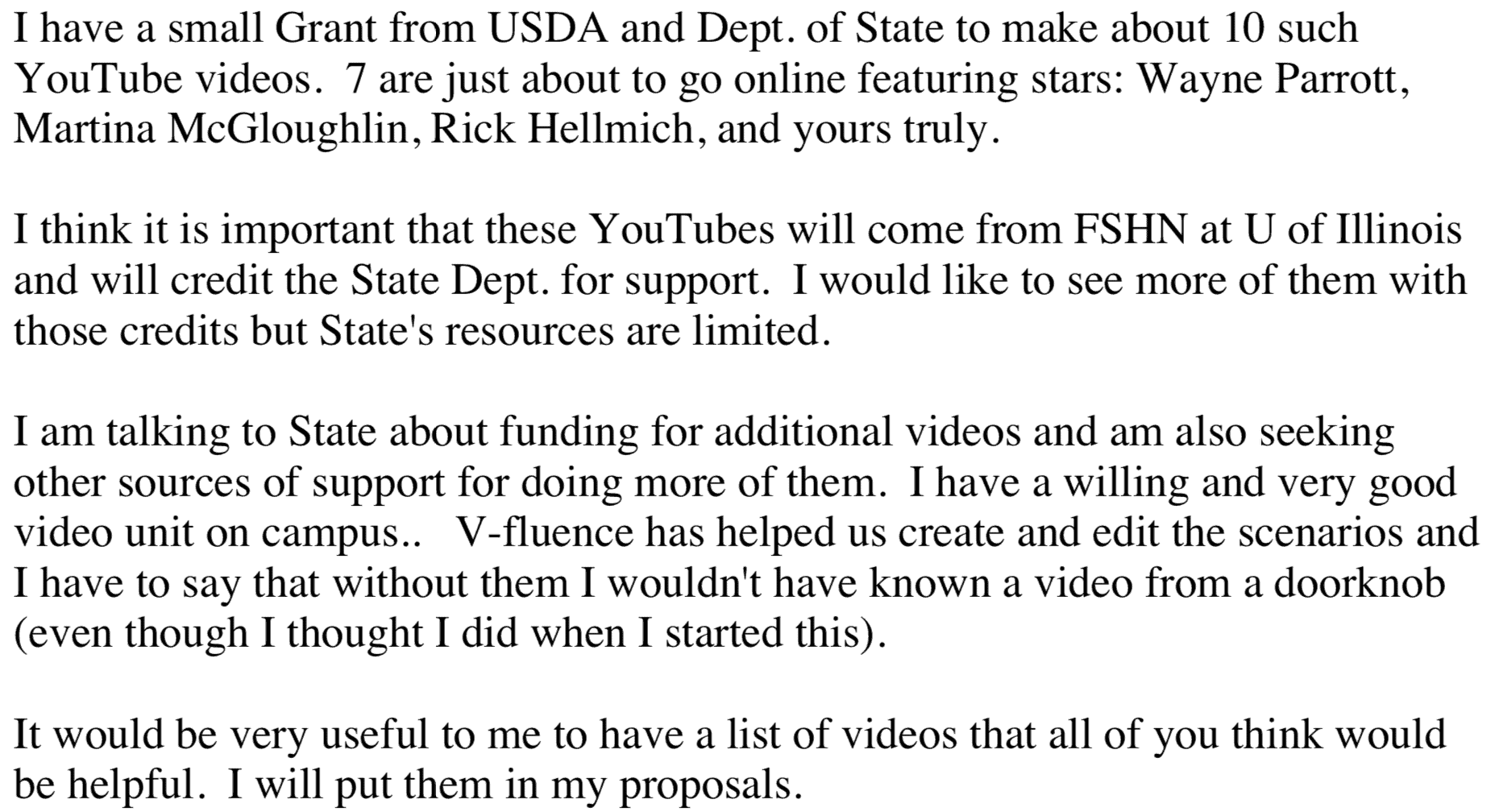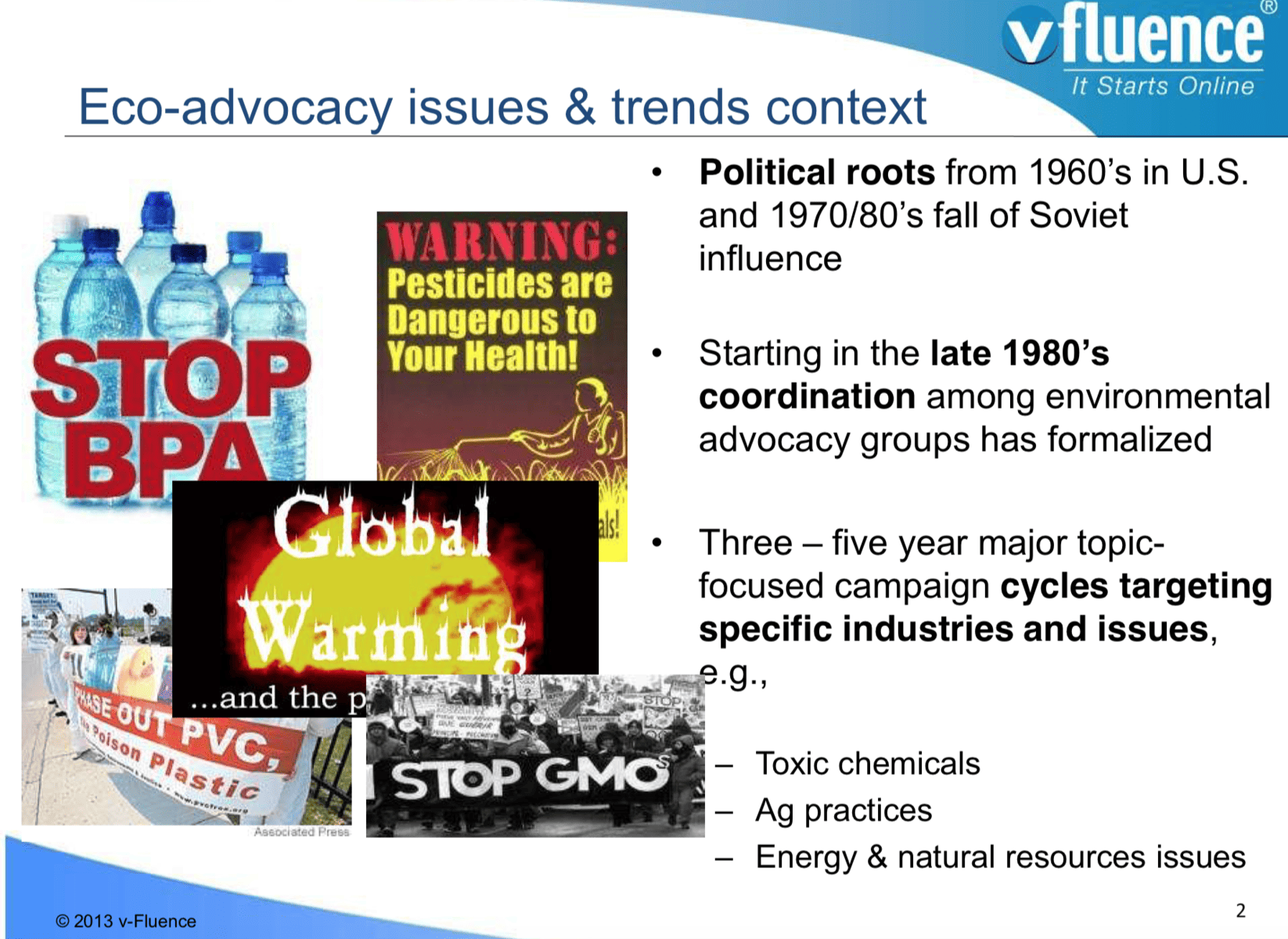Monsanto’s former Director of Corporate Communications Jay Byrne, president of the public relations firm v-Fluence, is a key player in the covert propaganda and lobbying campaigns of the world’s largest agrichemical companies. Emails obtained by U.S. Right to Know, posted in the UCSF Chemical Industry Documents Archive, reveal a range of deceptive tactics Byrne and other industry allies are using to promote and defend GMO foods and pesticides.
The examples here showcase how companies are shaping public perceptions from behind the cover of neutral-sounding front groups, government helpers and academics who appear to be independent as they work with corporations or their PR consultants.
Byrne ran program to attack critics of pesticides—with US government funding
A year-long investigation by Lighthouse Reports found the US government funded a PR operation that cast critics of GMOs and pesticides as an anti-science “protest industry.” The operation, run by Jay Byrne and v-Fluence, “built profiles on hundreds of scientists, campaigners and writers, whilst coordinating with government officials, to counter global resistance to pesticides.”
The investigation revealed that, “the US government funded v-Fluence as part of its program to promote GMOs in Africa and Asia” and that the US Agency for International Development (USAID) “channelled over $400,000 to v-Fluence for services” between roughly 2013 and 2019.
- US taxpayers funded a covert campaign to downplay the risks of pesticides and discredit environmentalists in Africa, Europe, and North America, by Lighthouse Reports, September 27, 2024.
- Revealed: the US government-funded ‘private social network’ attacking pesticide critics, by Carey Gillam, Margot Gibbs and Elena DeBre, The Guardian, September 27, 2024
Update: The Guardian reported on Feb. 10, 2025 that v-Fluence has halted its operations and shuttered its portal that profiled personal details of more than 500 environmental health advocates, scientists, politicians and journalists seen as critics of GMOs and pesticides (including staff at U.S. Right to Know) “after widespread backlash.”
More details: Below we describe Jay Byrne’s pitch to the U.S. government (with Jon Entine) to sway journalists to promote GMOs and pesticides. See also our coverage of Monsanto’s 31-page PR plan to counter the U.S. Right to Know investigations.
Clients: top agrichemical, agribusiness and drug companies
Byrne’s client list has included a range of the largest agribusiness and pharmaceutical companies and business groups, including the American Chemistry Council, Syngenta, AstraZeneca, Monsanto, Pfizer, the American Farm Bureau, National Corn Growers Association, Grocery Manufacturers Association, Rohm & Haas and the pesticide industry trade group CropLife.
The International Rice Research Institute (IRRI), which promotes genetically engineered “Golden Rice,” is also a client. Byrne played a role in PR efforts to attack Greenpeace and other critics of the GMO rice. See also the UCSF chemical industry documents library for many documents involving IRRI.
Cooked up academic front group to attack Monsanto critics
A key strategy of the agrichemical industry, as the New York Times reported, is to deploy “white hat” professors to fight the industry’s PR and lobbying battles from behind the cover of the “gloss of impartiality and weight of authority that come with a professor’s pedigree.”
In March 2010, Byrne and University of Illinois Professor Bruce Chassy discussed setting up a front group called “Academics Review” that could attract donations from corporations while appearing to be independent. Byrne compared the idea to the Center for Consumer Freedom (a front group run by infamous corporate propaganda front-man Rick Berman), which “has cashed in on this to the extreme; and I think we have a much better concept.”
Byrne described an “‘opportunities’ list with targets” they could go after. Byrne wrote to Dr. Chassy:

All those groups, people and topic areas “mean money for a range of well heeled corporations,” Byrne wrote. He said he and Val Giddings, PhD, a former vice president for the biotech trade group BIO, could serve as “commercial vehicles” for the academics.
In November 2010, Byrne wrote to Chassy again, “It will be good to get the next phase of work on Academics Review going – we’ve got a relative slow first quarter coming up in 2011 if business remains the same.” Byrne offered to “schedule some pro bono search engine optimization time” for his team to counter a GMO critic’s online influence. Byrne concluded the email, “As always, would love to find the next topic (and sponsor) to broaden this while we are able.”
In 2014, Academics Review released a report attacking the organic industry as a marketing scam; in its own marketing materials for the report, Academics Review claimed to be independent and did not disclose its agrichemical industry funding.
For more information:
- Monsanto Fingerprints Found All Over Attack on Organic Food, by Stacy Malkan, Huffington Post (6.30.2016)
- Academics Review: The Making of a Monsanto Front Group, USRTK fact sheet
‘US government-GLP-Byrne projects’ to sway journalists
Byrne’s lobbying and PR operations for the GMO and pesticide industry intersect at many points with the work of Jon Entine, who also provided PR services for pesticide companies. Entine directs the Genetic Literacy Project, which he launched in 2011 when Monsanto was a client of his PR firm. (Entine’s PR firm ESG MediaMetrics listed Monsanto as a client on its website in 2010, 2011, 2012 and up to January 2013, according to internet archives still available online.)
In December 2013, Entine wrote to Max T. Holtzman, who was then acting deputy undersecretary at the U.S. Department of Agriculture, to propose collaborating on a series of what he described as “US government-GLP-Byrne projects” to promote GMOs. Entine wrote to Holtzman:

Entine’s proposed “US government-GLP-Byrne” projects included a “Boot Camp and Response Swat Team” to prepare third-party academics for “potential legislative engagement on [GMO] labeling and related issues,” a “journalism conclave” to bolster media coverage about food security challenges and “provide coaching to younger journalists,” a global media outreach campaign to promote acceptance of biotechnology, and “multi-media content and placements from credible sources” reinforcing key themes “with segments and footage made available on U.S. government websites, GLP and other platforms.”
Holtzman responded, “Thanks Jon. It was great meeting you as well. I think your outline below provides natural intersection points where usda/USG messaging and your efforts intersect well. I’d like to engage further and loop other folks here at usda not only from the technical/trade areas but from our communications shop as well.”
Taxpayer-funded, Monsanto-aligned videos to promote GMOs
A series of taxpayer-funded videos produced in 2012 to promote genetically engineered foods provide another example of how academics and universities push corporate-aligned messaging. Byrne’s PR firm v-Fluence helped create the videos that were “designed to appear a little low budget and amateurish,” according to an email from University of Illinois Professor Bruce Chassy.
Dr. Chassy wrote to Monsanto employees on April 27, 2012:

Monsanto’s Eric Sachs responded:


Sachs offered to assist with messaging of future videos by sharing the results of focus group tests Monsanto was conducting. Dr. Chassy invited Sachs to offer suggestions for future video topics and asked him to send along the Monsanto focus group results.
Training scientists and journalists to promote GMOs and pesticides
In 2014 and 2015, Byrne helped Jon Entine organize the Biotech Literacy Project boot camps funded by agrichemical companies and co-hosted by two industry front groups, Entine’s Genetic Literacy Project and Bruce Chassy’s Academics Review. Organizers misleadingly described the funding for the events as coming from a mix of academic, government and industry sources, but the only traceable source of funding was the agrichemical industry, according to reporting by Paul Thacker. The purpose of the boot camps, Thacker reported, was “to train scientists and journalists to frame the debate over GMOs and the toxicity of glyphosate.”
Byrne was on the organizing team, along with Cami Ryan (who now works for Monsanto) and Bruce Chassy (who was receiving funds from Monsanto that weren’t publicly disclosed), according to emails from Entine and Ryan.
For more information:
- Flacking for GMOs: How the Biotech Industry Cultivates Positive Media—and Discourages Criticism, by Paul Thacker, The Progressive (7.21.17)
- Industry-funded Biotech Literacy Project Boot Camps, USRTK fact sheet
Bonus Eventus: the agrichemical industry’s social media echo chamber
A key service Byrne provides to agrichemical promotional efforts is his “Bonus Eventus community” that supplies academics and other industry allies with talking points and promotional opportunities. Internal documents (page 9) describe Bonus Eventus as “a private social networking portal that serves as a communication cooperative for agriculture-minded scientists, policy makers and other stakeholders.” Members receive Byrne’s newsletter, plus access to his reference library of agribusiness topics, “stakeholder database” of influential people in the GMO debate, and trainings and support for social media engagement.
Examples of the newsletter can be found in this cache of emails from Byrne to Peter Phillips, a University of Saskatchewan professor who has been criticized by colleagues for his close ties to Monsanto. In the Nov. 7, 2016 newsletter, Byrne urged Phillips and other recipients to share content about the “flaws and omissions” in a New York Times story that reported on the failure of GMO crops to increase yields and reduce pesticides, and the “mounting questions” facing an international group of cancer scientists who reported glyphosate is a probably human carcinogen – messaging that aligned with Monsanto’s PR plan to discredit the cancer research panel. (See also our fact sheet on Peter Phillip’s secret “right to know” symposium).
Byrne urged the Bonus Eventus community to share content on these themes from industry-connected writers, such as Julie Kelly, Dr. Henry Miller, Kavin Senapathy, The Sci Babe and Hank Campbell of the American Council on Science and Health, a group Monsanto was paying to help discredit the cancer scientists. In 2017, Forbes deleted dozens of articles by Dr. Miller – including several he co-authored with Kelly, Senapathy and Byrne – after the New York Times reported that Dr. Miller had published an article in Forbes under his own name that had been ghostwritten by Monsanto.
Gatekeeper for attack on Greenpeace
When a group of Nobel laureates called on Greenpeace to stop opposing genetically engineered rice, it looked like an independent effort. But behind the curtain of impressive credentials were the helping hands of two key players in the agrichemical industry’s PR lobby: Jay Byrne and a board member of the Genetic Literacy Project. Byrne was posted at the door at a 2016 National Press Club event promoting a group called Support Precision Agriculture. The .com version of that website redirected for years to the Genetic Literacy Project, a front group that works with Monsanto on PR projects without disclosing those ties.
So who paid for the anti-Greenpeace press event? Sir Richard Roberts, a biochemist who said he organized the Nobel laureate letter, explained the backstory in an FAQ on the website: the “campaign has been pretty inexpensive so far,” he wrote, consisting mostly of his salary paid by his employer New England Biolabs and “out-of-pocket expenses” paid by Matt Winkler. Winkler, founder and chairman of the biotech company Asuragen, is also a funder and board member of Genetic Literacy Project, according to the group’s website. Roberts explained that Winkler “enlisted a friend, Val Giddings,” (the former biotech trade group VP) who “suggested Jay Byrne” (Monsanto’s former communications director) who offered pro bono logistical support for the press event.
Byrne and Giddings also helped orchestrate the industry-funded Academics Review, a front group they set up to appear independent while serving as a vehicle to attract corporate cash in exchange for attacking critics of ag-biotech products, according to emails obtained by U.S. Right to Know. In the emails, Byrne named Greenpeace on the “targets” list he was compiling for Monsanto. Another of Byrne’s clients is the International Rice Research Institute, the main industry group trying to commercialize GMO Golden Rice, which was the focus of the Greenpeace critique. Research by Glenn Davis Stone of Washington University in St. Louis has found that low yields and technical difficulties have held up Golden Rice.
In his FAQ, Dr. Roberts dismissed Dr. Stone’s independent research as “not an accurate representation of the state of affairs,” and instead pointed to industry-connected PR sources who will be familiar to readers of Byrne’s Bonus Eventus newsletter: Julie Kelly, Henry Miller and Academics Review. The press event took place at a critical political moment, and generated a helpful story in the Washington Post, a week before Congress voted to prohibit states from labeling GMOs.

For more information:
- How The #Nobels4gmos Campaign Is Rife With Biotech Industry Ties, by Vincent Harmsen, One World (7.11.16)
- 107 Nobel Laureate attack on Greenpeace traced back to biotech PR operators, by Jonathan Latham, PhD, Independent Science News (7.1.16)
- I was barred from a Nobel Laureate press conference by a PR consultant with Monsanto ties, by Tim Schwab, Food & Water Watch (7.6.16)
- Greenpeace to Nobel laureates: it’s not our fault Golden Rice has ‘failed as a solution, ’ by Lorraine Chow, EcoWatch (6.30.2016)
Weaponizing the web with fake people and websites
Reporting for The Guardian in 2002, George Monbiot described a covert tactic that agrichemical corporations and their PR operatives have been using for decades to promote and defend their products: creating fake personalities and fake websites to silence critics and influence online search results.
Monbiot reported that “fake citizens” (people who did not actually exist) “had been bombarding internet listservers with messages denouncing the scientists and environmentalists who were critical of GM crops” – and the fake citizens had been traced back to Monsanto’s PR firm Bivings.
Monbiot described Jay Byrne’s connection to Bivings:
“think of the internet as a weapon on the table … somebody is going to get killed.”
“At the end of last year, Jay Byrne, formerly [Monsanto’s] director of internet outreach, explained to a number of other firms the tactics he had used at Monsanto. He showed how, before he got to work, the top GM sites listed by an internet search engine were all critical of the technology. Following his intervention, the top sites were all supportive ones (four of them established by Monsanto’s PR firm Bivings). He told them to ‘think of the internet as a weapon on the table. Either you pick it up or your competitor does, but somebody is going to get killed.’ While he was working for Monsanto, Byrne told the internet newsletter Wow that he ‘spends his time and effort participating’ in web discussions about biotech. He singled out the site AgBioWorld, where he ‘ensures his company gets proper play’. AgBioWorld is the site on which [fake citizen] Smetacek launched her campaign.”
For more information:
- Corporate phantoms, by George Monbiot, The Guardian (5.29.02)
- The covert biotech war , by George Monbiot, The Guardian (11.18.02)·
More from Jay Byrne
A 2013 Power Point presentation showcases the role Byrne plays for his clients in the agrichemical industry. Here he explains his theories about eco-advocates, ranks their influence online and urges companies to pool their resources to confront them, in order to avoid “regulatory and market constraints.”

The 2006 book “Let Them Eat Precaution,” published by the American Enterprise Institute and edited by agrichemical industry PR operative Jon Entine, contains a chapter by Byrne titled, “Deconstructing the Agricultural Biotechnology Protest Industry.”
Byrne is a member of “AgBioChatter,” a private email listserve that agrichemical industry senior staffers, consultants and academics used to coordinate messaging and lobbying activities. Emails obtained by U.S. Right to Know show Byrne encouraging members of AgBioChatter to try to discredit people and groups that were critical of GMOs and pesticides. A 2015 Monsanto PR plan named AgBioChatter as one of the “industry partners” Monsanto planned to engage to help discredit cancer concerns about glyphosate.
For more information:
- Secret documents expose Monsanto’s war on cancer scientists, by Stacy Malkan, TruthOut (7.16.18)
- Tracking the agrichemical industry PR network, USRTK fact sheet
This post was originally posted in 2019 and updated in 2025 with new information about the findings of Lighthouse Reports.









